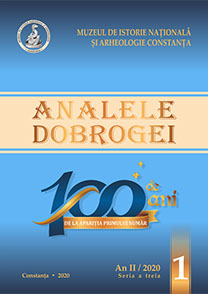PARTENERIAT STRATEGIC SECOND HAND:
PROPAGANDA COMUNISTĂ ŞI ÎNCEPUTUL RELAŢIILOR DIPLOMATICE ROMÂNO-POLONE (1945-1946)
STRATEGIC SECOND HAND PARTNERSHIP:
THE COMMUNIST PROPAGANDA AND THE BEGINNING OF ROMANIAN-POLISH RELATIONS (1945-1946)
Author(s): Florin AnghelSubject(s): History, Diplomatic history, Political history
Published by: Muzeul de Istorie Națională și Arheologie Constanța
Keywords: Communism; Poland; Romania; Romanian-Polish relations in 1945-1946; memorz; cordon sanitaire;
Summary/Abstract: Romania and Poland were not on the same side at that moment, a year after the end of the Second World War: neither in terms of the relations with USSR, nor in those with the occidental Allies, USA and Great Britain. Poland, found in the front row of the negotiations between the Allies and being the object of the global conflict outburst in Europe, was benefiting from all tools of international representation, being included amongst the founding members of the United Nations Organization. Sure enough, the relation with the Soviet Union imposed, first of all, political and ideological subjugation in terms of the authority of the government in Lublin installed by the Soviets in July 22nd 1944. The bilateral relations of this new Polish state with USSR were considering the strategical interest and the financial and economic needs of Moscow. The staff modifications in the Romanian diplomacy, partial after March 6th1945 and total after the appointment of Ana Pauker (November 7th 1945), have cancelled not only the resources of efficiency, competence and strategy of part of the clerks and diplomats, yet they have also narrowed the Romanian exterior politics down to a mere office for the translation of documents elaborated in Moscow, for more than a decade. And the ravages of such modifications did not concern only the relations of historical partnership with the states in the region, which were sometimes cancelled due to the illiteracy of those to have populated the Ministry of Foreign Affairs after year 1945 (and here we can also largely include the relation with Poland), yet these damages were also present in the relationship with the Great Powers, others than USSR. In its turn, the Polish diplomacy was in full process of reorganization after 1945 in terms of: the authority transfer from the government in exile from London, the preparation of the human resources for the missions abroad (starting with 1945 in Warsaw was functioning a Diplomatic School), the repatriation of those exiled and of the war prisoners, the reshaping of the interests of diplomatic representation. Therefore, while until 1939 the Polish Republic held in Romania an embassy, three consulates (Bucharest, Cernăuți, Chișinău) and several honorific consulates, after 1945 the newly installed power in Warsaw opened no consular representation. The political and ideological memory of the interwar sanitary cordon, from the Baltic Sea to the Black Sea, meant to restrain the Kremlin’s appetite in regaining the territories lost in 1917-1918 and in significantly influencing the interior politics of the „proximity empire” – the states in the immediate vicinity and close by – was abandoned after 1945, both in Warsaw and in Bucharest. The new ideological rules yet also the practices of the Soviet occupation have imposed a redefinition of the Romanian-Polish relations up to the point of becoming irrelevant and insubstantial for almost half a century. The elites of the two totalitarian parties, installed as governing parties until 1989, and the ideological and intellectual societies have constituted – by fear, lack of integrity or by deliberate dissipation of the historical memory – a tedious partnership between two communist states, with pretensions of being original within diplomats lacking commitment. Briefly we can define this as: half of a century of communist partnership with a historical background about nothing.
Journal: Analele Dobrogei
- Issue Year: I/2020
- Issue No: II seria3
- Page Range: 229-248
- Page Count: 20
- Language: Romanian

